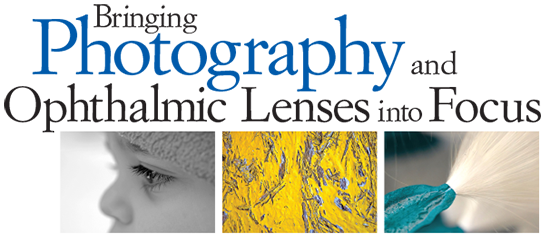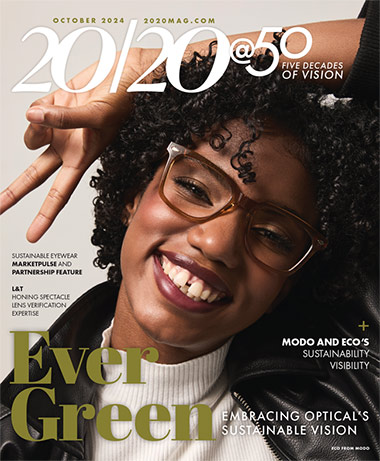
Photos: Renee Wheelock, Eye SPy Art
Renee Wheelock was about 11 years old when her parents bought her a camera, “a popular instamatic film camera with a square flashbulb on top,” she recalls. “It opened up my world at the time to an entirely different, bigger world, and I began documenting life in pictures.”
Wheelock began her optical career in 1988. Since then, she has worked in all aspects from dispensing, lens/coating manufacturing sales to lens/coating wholesale lab sales. She started with Nikon Lenswear U.S. in 2007 and is currently Nikon’s East Coast territory manager. As she explains, “It is a perfect fit, as I have made it my life’s mission to help people see more clearly, coupled with my love of photography. My passion has always been pointed toward combining my professional success in ophthalmic lens sales and photography, depicting how both relate to one’s visual perception.”
In the late ’90s, Wheelock began pursuing photography as a serious hobby. Then, eight years ago, she fell in love with macro photography and began to market her images through her company, Eye Spy Art. “Most likely, it was due to my ophthalmic lens career connection,” she says. “In the ophthalmic lens field, we tend to be very detailed-oriented, and I love the details I get with my Nikon macro lens and pro-camera.”
A portfolio of Wheelock’s photos can be seen on her website
eyespyart.com and on her Facebook page. The images are available to eyecare professionals for in-office décor.
—Andrew Karp
 L&T: You work for Nikon, one of the most famous camera brands and one of the few companies to make both cameras and ophthalmic lenses. What are the synergies between these two sides of Nikon’s business?
L&T: You work for Nikon, one of the most famous camera brands and one of the few companies to make both cameras and ophthalmic lenses. What are the synergies between these two sides of Nikon’s business?
Wheelock: A camera lens uses a series of 10 to 50 lenses to create a precise image. The same technology that is used to create Nikon’s professional grade digital camera lenses is also used to create the Nikon Lenswear series of ophthalmic lenses. Each camera lens is designed and perfected using the Nikon Optical Design Engine (N.O.D.E.) just as each Nikon Ophthalmic Lens is created, optimized and in many cases, even personalized by the same N.O.D.E. system for each individual wearer. Prior to each individual Rx being processed in one of our two Nikon Lenswear U.S. laboratories, each Nikon Lenswear digital lens design is sent electronically to Japan to be calculated and optimized by N.O.D.E, and the optimized calculations returned to the laboratory to precision craft each lens.
How do you capitalize on these synergies when positioning Nikon lenses to your accounts?
Nikon is famous for its technology, and I am very proud to be working for a company with an amazing reputation for optics and coatings. I have worked with Nikon Lenswear U.S. on the East Coast, since they set up direct U.S. distribution in 2007. Since then, we have launched some of the most technically advanced lens designs and technology in the U.S. market. A little known fact is that Nikon pioneered 1.74 material and blue light control technology AR. I use these innovations and our N.O.D.E. system to connect Nikon camera designs to our ophthalmic Nikon Lenswear designs. Nikon manufactures both with this system.
In what ways does Nikon apply its expertise in camera optics, precision optics and other related fields to its ophthalmic lenses?
At the heart of every Nikon product there is an optical lens, from cameras and IC steppers, to microscopes and range finders. The N.O.D.E. system is used to design each one of these Nikon lenses. The Nikon Core Technology Center is another way that Nikon’s cutting-edge technology is shared across the wide-ranging areas of Nikon’s business units, such as optics, precision measuring and manufacturing, image processing, optics, materials, and software and systems.
Do you see a connection between digital lenses and digital photography, and if so, how do you explain that connection?
“Digital lens technology” is quite simply explained. If you take a conventional PAL and process it digitally; it is still the same PAL. If you design a PAL digitally and process it digitally, depending on the engineered design, it can widen the viewing field, improved visual clarity and provide sharper visual acuity. The same can be seen in today’s DSLR cameras when comparing them to a film camera of yesteryear or a basic digital point-and-shoot camera of today. The more advanced the camera lens design, the better the image and print quality seen. The more advanced the ophthalmic lens design, the sharper and clearer the image, and the wider the field of vision.
What fascinates you about the ways in which our eyes capture images and the ways in which cameras do?
Eyes capture an image in a similar fashion to a camera; the camera, with the talents of a photographer, freezes the moment in time we see with our eyes. We all have a different definition or perception of what our eyes see, that too is fascinating to me. With our eyes, our visual history and life experiences form our unique, one-of-a kind perception. The eyes are so connected to emotions, and as a photographer, I capture an image evoking that emotion to last longer than the nanosecond in time that one experiences it. It is then up to the viewer to interpret and memorize via sight. The power of the human eye, our vision and the camera’s eye are all incredible gifts… gifts that we should protect by using the best in lens technology, to allow us to see those precious details of life.
I am fascinated with the details of nature. Our life and vision are both so automatic that in today’s very rushed visual world, we often don’t take the time to appreciate the complexities of the beauty around us. With my macro photography and optical experience, I hope to rekindle the viewers’ sight by showing the details of colors, shadows and light in many different forms. My photography allows the viewer to savor a nanosecond in time, giving the ability to translate these moments into memorable visual gifts. The eyes… hence the name Eye Spy Art.
What drew you to macro photography?
My desire to see things extremely up close and the science of light both play a big role. Macro photography allows me to artistically record the subjects up close, and I love to use numerous light sources. I try to use my photography and optical experience to take a macroscopic look at life’s precious details, restoring my sight and the viewer’s sight to see the world with an improved, keen eye.
How does your knowledge of ophthalmic lenses and optics inform your photography?
Keeping in mind that the human eye is far more delicate and perfect than any camera or lens, I look at the details of a given subject and try to artistically capture the details with my camera, a Nikon of course. This process is somewhat meditative to me, having an awareness of the things we normally miss seeing, even though we do see them every day; like a small flower emerging from a crack in the sidewalk, something that one would normally walk over without a second glance.
How does your work as a photographer influence your approach to selling lenses?
It all comes down to the art of seeing and how seeing connects to Nikon Lenswear’s technology. The eyes are so connected to our brains and emotions; as a photographer, I aim to capture an image in perfect sight. I believe passionately that Nikon Lenswear’s amazing technology provides the wearer with the ability to see beauty, as sharp, clear and defined as a professional grade digital camera of today can capture details. Our life and vision are both so automatic that in today’s very rushed visual world, we often don’t take the time to appreciate the complexities of the beauty around us. My work as photographer and with Nikon Lenswear aims to rekindle the sight of others by showing the details of colors, shadows and light in many different forms. Vision is sacred. I encourage people to choose the best quality for their vision. ■










